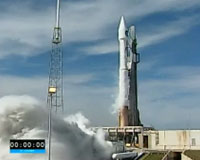 |
Brasilia, Brazil (XNA) Feb 16, 2010 Brazil and China will postpone their fourth joint satellite launching from 2010 to mid-2011, a Brazilian official said Wednesday. The two parties held a critical design review meeting a few days ago and decided to reschedule the date for launching the satellite CBERS-3, said Thyrso Villela, director of satellites, applications and development of the Brazilian Space Agency (AEB), in an interview with Xinhua. Brazil and China established in 1988 a joint committee for the construction, launching and operation of satellites under the China-Brazil Earth Resources Satellite (CBERS) Program. The program allows the two countries to gather information about the Earth's environment, agriculture, urban development planning and water pollution. "The AEB is very happy about this fruitful cooperation between China and Brazil, which is the main cooperation program of our country," said Villela. At the initial phase (1988-2003), two satellites, CBERS-1 and CBERS-2, have been sent into space. The first one was launched in October 1999 and the second in October 2003. In 2002, the two countries signed a new protocol of cooperation, starting the second phase of the partnership. In September 2007, CBERS-2B was launched to maintain the supply of images in the period of time between the end of CBERS-2 operation and the launching of CBERS-3. According to Villela, the first three satellites had 70 percent of their construction under China's responsibility. The CBERS-3 and CBERS-4 will be equally shared between Brazil and China. "Nowadays we've fulfilled much of what the Brazilian space program needs. We have trained a lot of people. Today we count on technical and scientific experts that started to be trained in 1988, which forms a solid foundation for us in space science," said Villela. He also said Brazil counts on an increasing level of investment on space research and a considerable amount of money has been diverted to the sector during the last eight years. "It (the cooperation) is a good example for the rest of the world: two developing countries could get together and set up a project with high technological content and provide useful data for our societies," said Villela. He said there is much to be done in Brazil, a country that faces many other problems that may seem more urgent than a space program. "However, we precisely want to show the society that investing in space area is not superfluous because much is repaid to the society," he said. Villela cited the possibility to foresee natural disasters, meteorological forecast and deforestation monitoring as examples of benefits of satellite-generated images for the society. According to Villela, 1 million images provided by CBERS satellites have been distributed and about 40,000 people check these images frequently, since they can be accessed on the Internet for free. Besides the cooperation program with China, Brazil also has joint programs with Argentina, France, the United States and Ukraine.
Source: Xinhua News Agency
Share This Article With Planet Earth
Related Links Brazilian Space Agency (AEB) Launch Pad at Space-Travel.com
 NASA launches space-based solar observatory
NASA launches space-based solar observatoryCape Canaveral, Florida (AFP) Feb 11, 2010 NASA launched a first-of-its-kind solar observatory into space Thursday in hopes of expanding scientists' understanding of the sun and its complicated workings. A two-stage Atlas rocket roared off its launch pad from the Kennedy Space Center in Cape Canaveral, Florida at 10:23 am (1523 GMT), carrying NASA's Solar Dynamic Observatory (SDO) into space. NASA said the solar probe successfull ... read more |
|
| The content herein, unless otherwise known to be public domain, are Copyright 1995-2010 - SpaceDaily. AFP and UPI Wire Stories are copyright Agence France-Presse and United Press International. ESA Portal Reports are copyright European Space Agency. All NASA sourced material is public domain. Additional copyrights may apply in whole or part to other bona fide parties. Advertising does not imply endorsement,agreement or approval of any opinions, statements or information provided by SpaceDaily on any Web page published or hosted by SpaceDaily. Privacy Statement |